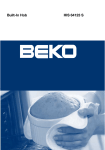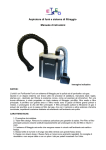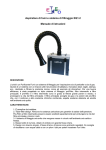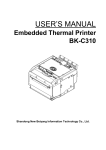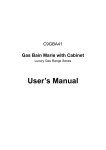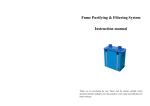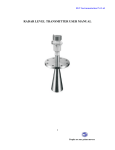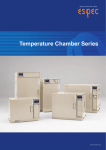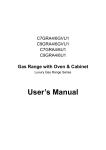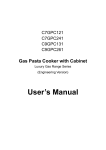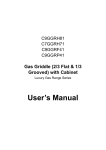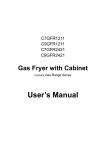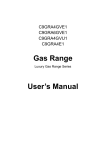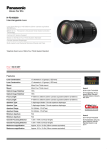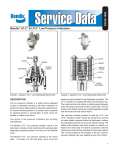Download User`s Manual
Transcript
C7GRA4EVE1、C9GRA4EVE1 C7GRA6EVE1、C9GRA6EVE1 Gas Range with Electric Oven Luxury Gas Range Series User’s Manual Dear Client & User, Firstly, thanks for purchasing and using our product. All the information and guidelines of this user’s manual comply with certain applicable regulations, which come out from our long-term accumulated knowledge and experience as well as current project development situations. Limited to some special structures, additional specified items or new technology changes, the actual usage situation might be some different from what stated in this user’s manual. Should you have any question, please do not hesitate to contact the manufacturer via the method shown in back cover page of this manual. For safety purpose and efficient operation, please make this document available to users for reference. Do have them to read this manual carefully before carry out any action on this device, especially when starting. The manufacturer declines any responsibility in the event users do not follow the instructions or guidelines stated here. The user’s manual should be placed close to the device, in convenience of users’ reading before operation. We have the full authority to reserve the further technical changes of the device, in the scope of further performance improvement characteristic development. Warning Any self-modification, wrong installation, adjustment or maintenance can lead to property loss or casualty. Please contact the manufacturer for any adjustment or maintenance, and have the work done by a trained & qualified person. For your safety sake, please keep the machine away from any liquid, gas or other object, which is flammable or explosive. This appliance should not be operated by those who have physiological, perceptual or mental disabilities or those who have insufficient experience or knowledge (including children). Only in conditions of being given sufficient supervise & guarantee of personal safety, as well as proper instructions & guidance, those who were mentioned above can make some particular operation of this device. Keep children away from the device. Preserve this manual safely. When passing on/selling the device to a third party, the manuals must be handed over along with the device. All users must operate the device complying with the user’s manual and related safety guidelines. If this appliance is placed near walls, partitions or kitchen furniture and the like, it is advisable to make these facilities with non-combustible material, otherwise cover them with non-combustible heat-resistant material, and pay attention to fire prevention regulations. The appliance should be installed in a well-ventilated area, if possible under a vent hood, in compliance with all applicable regulations in force. This will ensure that all burnt gases produced during the combustion process are completely exhausted. The appliance is only applicable to low-pressure gas regulating valve. It may cause property loss or safety accidents if high or medium pressure regulating valve is used. Fire warning: If you smell the gas, please keep away from any fire source. Do not light up any device or touch the electronic switch. Do not use any phone in the building either. Close the main gas valve immediately and call the professional personnel to maintain it. Operate by force or maintain improperly will lead to large gas leakage or deflagration easily. The manufacturer won’t bear any responsibility for fire hazard caused by improper operation or maintenance. Housing of the appliance must be grounded to ensure safety. Thanks for your cooperation! Contents 1. Functional Introduction...................................................1 2. Structure Schematic Diagram & Working Principle...............1 3. Basic Features & Parameters........................................3 4. Precautions & Recommendations..................................5 5. Working Instructions & Operation Flow..........................8 6. Routine Inspection.........................................................12 7. Cleaning & Maintenance................................................12 8. Failure Analysis & Trouble Shooting..............................13 1. Functional Introduction This product is manufactured by our company, which is combined with advantages from home and abroad. It is novel in design, reasonable in structure, easy in operation, durable in using and convenient in maintenance. The chamber, whose size is in accordance with the standard size of gas oven, is made of high-quality stainless steel and covered by high density glass fiber that can preserve heat constantly. The door is made of double-deck glass fiber with a good thermal insulation. The door surface is made of stainless steel and the handle is Bakelite product, which is insulated and has a good thermal protective performance, with a spring hinge. 2. Structure Schematic Diagram & Working Principle 2.1 Structure Schematic Diagram C9GRA4EVE1 1 2.2 Structural & Functional Features: 1. High-quality stainless steel made. 2. With good impermeability, no food residues will be left out. 3. High-quality oxidation cast-iron burner. 4. Equipped with flame failure safety protection device. 5. Adjustable flame. 6. Heat-resistant enamel baseboard. 7. Adjustable high-quality stainless steel feet. 8. Fast heating up, easy operation and convenient maintenance. 9. Convertible nozzles, suitable for various gases. 10. Gas valve is brass made, with safety device and thermocouple, preventing gas leakage and fire hazard. 11. Knob of gas valve is Bakelite die casting, an insulation, heat-proof. 12. Enamel surface treatment of oven board, easy to clean, very sanitary and clean. 13. Heating for oven combines top and bottom heating with hot-air convection etc. 14. Independent and random thermostatic control, energy saving. 15. Desired oven temperature can be set according to requirements and food condition. 2.3 Electrical Diagram Gas Range with Electric Convection Oven 2 Gas Range with Electric Oven 3. Basic Features & Parameters 3.1 Basic Model Model C7GRA4EVE1 C7GRA6EVE1 C9GRA4EVE1 C9GRA6EVE1 Dimension(mm) 700×700×850+60 1050×700×850+60 800×900×850+60 1200×900×850+60 LPG 24 36 30 45 NG 24 36 30 45 Oven Power(kW) 4.8 4.8 6.5 4.8 Voltage(V) 380 380 380 380 N/W(kg) 111 144 136 179 Power (kW) 3 3.2 Non-Basic Model: (For gas range mainly, user can choose different combination in accordance with actual requirement. For the total power, please refer to the nameplate.) Burner Power (KW) Gas Consumption NG LPG NG (M3/H) LPG (KG/H) Big Burner (2-crown) 9 9 0.95 0.75 Big Burner (1-crown) 7.5 5.6 0.79 0.47 Middle Burner 4.5 4 0.48 0.33 Small Burner 3.5 2.8 0.37 0.23 3.2.1 Big Burner with 2-crown (burner diameter: φ75mm) 3.2.2 Big Burner with 1-crown (burner diameter: φ75mm) 4 3.2.3 Middle Burner with 1-crown (burner diameter: φ67mm) 3.2.4 Small Burner with 1-crown (burner diameter: φ47mm) 4. Precautions & Recommendations 4.1 Transportation and Storage During transportation, the machine should be carefully handled and do not put it upside down to prevent from damaging to the shell and inside. The packaged machine should be stored in a ventilated warehouse without corrosive gas. If it needs to be stored in open air temporarily, measurement against raining is needed. 5 4.2 Notice for Installment Gas Connection: 1. Before installation, a quick acting disconnecting valve should be installed upstream the appliance where is easy to reach. 2. Making sure the applicable gas is the same as the supplied one. If not, stop using. 3. Pipeline connected to the appliance should be connected with proper metal pipe. 4. Test the appliance with LPG first. 5. If the pipeline pressure is 10% higher or lower than the rated pressure, please install a pressure regulator to adjust the gas pressure to reach the rated one. 6. After connecting the appliance to the gas system, check for leaks at joints and pipe fittings; to do so, use soapy water or a specific leak detector (spray). “No Flaming!” Electrical Connection: 1. The appliance is equipped with an earth bolt at its back, which should be connected with copper wire no less than 1.5mm² and earth wire that conforming to safety regulations reliably. 2. After installation, check that whether the connection is loose, whether the voltage is normal and whether the safety grounding is reliable. 3. The fixed arrangement of wire should be equipped with an all-poles disconnecting switch with a contact opening of 3mm on its poles. It is advisable to install a grounding leakage protection switch. Do not pile up sundries in front of the switch, for convenient operation sake. 4. Adjustable temperature: 50-300℃; recommended operating temperature: 180-250℃. Notes: 1. 2. 4. Installation should be done by professional technician. Take out the attached battery, turn the pulse button counterclockwise, then put in the battery in the correct direction as shown and tighten the pulse button. Appliance connection should conform to provisions in gas safety, installation and operation. The appliance should be installed separately or assembled with other devices in 5. specified scope. The appliance should keep a minimum clearance of 10cm away from 3. 6. 7. non-combustible substance (e.g. walls, windows etc.) on both sides, and 20cm at its back. Do not install the appliance on flammable floor or materials. During installation, please consider the weight of the appliance. It is advisable to install on the floor. The appliance should be installed in a well-ventilated area, if possible under a vent hood, in compliance with all applicable regulations in force. This will ensure that all burnt gases produced during the combustion process are completely exhausted. 6 8. After installation, keep the appliance stable and level. Do not tilt or sway during 9. operation. Before installation, remove the outer plastic films and clean the residue on stainless steel sheet with appropriate substance. 10. Check that the device is pre-set to use the gas family or voltage available at the place of installation. Before installation, make sure that the supply gas (voltage) is the same as the gas (voltage) that the device allows to use. 11. Do not use gas that not applicable to the appliance as fuel, neither does high-pressure or medium-pressure regulating valve. (This appliance is only applicable to low-pressure regulating valve.) 12. The supply voltage should comply with the working voltage of the appliance. 13. Do not place flammable substance (e.g. towel etc.) on anywhere of the furnace surface, otherwise, it may cause fire hazard. 14. After working, turn off the gas valve and power switch immediately. 15. If gas leakage is found, turn off the gas valve immediately and open the windows to ventilate. Do not turn the power and switches on or off. Reuse the appliance after maintenance. 16. Vicinity of the mounting position should not store flammable or explosive objects. The ambient temperature should be lower than 45℃ and the relative humidity should be below 85%. 4.3 Special Notice 1. 2. Installation, initial use and maintenance should be done by professional or licensed personnel or franchised person approved by manufacturer. Please keep the integrity of the appliance and remove the outer packaging. If you do have any questions, call the specialist and stop using the appliance. To avoid danger, keep the packing materials away from children. (For the materials are plastic bags, nails etc.) 3. 4. To avoid hazard, turn the appliance off if not going to used it or if it is unattended. This product is a commercial machine that needs to be operated by trained personnel, not applicable for household use. 5. This product is only for commercial use, not suitable for other uses, or it may cause danger. 6. Do not sway or tilt the appliance during operation. 7. Do not dismantle or self-modify the appliance. Dismantlement and self-modification may cause casualty. 8. Before cleaning, unplug and cut off the power supply. 9. During cleaning, do not aim at the appliance with water jet. Water may conduct electricity, it may cause electric shock due to leakage. 10. Do not pat the product or put any heavy objects onto it. Do not place any objects in the smoke vent. Obstruction of smoke exhaustion may do harm to health. 7 11. Abnormal operation may cause appliance damage and danger. 12. High temperature may cause scald. Do not touch the appliance directly with hands due to high temperature during or after operation, especially the high-temperature area. 13. Do not use extra power supply (gas) that not marked on the product. 14. Do not use power knife or quick acting disconnecting valve that not conforming to safety standard. 15. Do not destroy the control panel with hard or sharp objects. 16. To prevent damage, turn off the switch ASAP when near the thunder zone. 17. After working, turn off the power knife and quick acting disconnecting valve. 18. If the power cord is damaged, to avoid hazard, substitution should be done by manufacturer or its maintenance department or similar professional personnel. 5. Working Instructions & Operation Flow 5.1 Gas Range: 5.1.1. Control Knob: It will be OFF when the red needle aligns with the 0 position. ignition MAX MIN 8 5.1.2 Ignition: Press down the control knob and rotate it counterclockwise to align “ ” with the zero salient point. At this time, hold the knob and push down the igniter simultaneously to light up the pilot flame. (Initial ignition may be a little longer due to the air existing in the pipeline. The pilot flame can be normally ignited when the air is exhausted completely.) After ignition, release the knob 20s later. Turn the knob to MAX or MIN according to food requirements. 5.1.3 Flameout: Press down the control knob and rotate it clockwise to the zero salient point ●. Turn off the main gas supply. 5.1.4 Replacing the Main Nozzle(Picture 4): Prepare tools involved. Dismantle the burner frame, gas ring, burner base and take out the basin, then remove the nozzle and substitute it with a matched one. Fasten the nozzle and replace the basin, burner base, gas ring and burner frame in order. As for oven, take apart the lower panel of the oven door and discharge the nut and nozzle holder with an appropriate spanner, then substitute with a matched nozzle. Fasten the nozzle and detect for leakage, then seal the panel. 5.1.5 Replacing the Pilot Nozzle(Picture 4): Position a proper spanner on the nut of the pilot support to balance the twisting stress. Discharge the screw fixing the thermocouple with a straight screwdriver and remove the thermocouple. Dismantle the nut fixing the aluminum pipe and remove the pipe. Remove the pilot nozzle and replace with an appropriate one. It is unnecessary to regulate the primary air. 9 5.1.6 Adjusting the Pilot Nozzle : Position a proper spanner on the nut of the pilot support to balance the twisting stress. Discharge the bolts at bottom of the support with a straight screwdriver. Unscrew the screw in the support counterclockwise to adjust the flame. Primary air can be regulated in accordance with gas type. Notice: After the adjustment of the pilot nozzle and the replacement of the main flame nozzle, gas leakage must be checked. 5.2 Electric Convection Oven: 5.2.1 Switch Function (The functions can be achieved by aligning the level switches with 0 point.) level switch fan top & bottom heating element rear heating element with fan It will be OFF when the red needle aligns with the 0 position. bottom heating with fan element top heating element with fan bottom heating element top heating element 10 working indicator manual reset thermostat, set range: 50-300℃ timer, set range: 20-120min manual function (When selected, there is no time limit.) 5.2.2 Operation Principle: 1. Before using, check that whether the power installation is correct, and make sure that the supply voltage complies with the working voltage of the appliance. 2. Connect the power supply, the green indicator illuminates, which indicates that the appliance is energized. 3. Have the desired temperature and time set, then select the desired function on the level switch to start working. At this time, the working indicator illuminates, which indicates that the heating elements are heating up the oven. 4. Temperature is adjustable by the will of users according to food type, 180℃-250℃ is recommended. It takes about 8-10 min to reach 250℃ from power on. 5. There are 7 different levels on the level switch, each with distinct function, users can shift among the functions according to actual requirement. 6. When the set point is reached, the thermostat will cut off the power supply automatically with the yellow indicator off. The heating elements stop working and the oven keeps in a constant temperature. 7. If the temperature drops a bit, the thermostat will connect the power supply automatically. The heating elements restart heating up the oven. The procedure circulates. 11 8. After working, turn the thermostat, timer and level switch counterclockwise to OFF position, then shut down the power switch to cut off the power supply. 6. Routine Inspection It is necessary to check the machine daily. Check the machine regularly can avoid serious accident happens. Stop using if user feels that there are some problems in the circuit or machine. Check the situation of the machine before or after using every day. Before using: Whether the machine is tilted? Whether the control panel is damaged? Whether the power cord is aging, cracking or damaged? During using: Whether there is strange odor or vibration noise? Whether the temperature is out of control or any electric leakage? Whether the burner flame is normal? Any light back or flameout? 7. Cleaning & Maintenance 1. 2. Clean the burner and crumb tray regularly. Clean the dirt on burner and baffle regularly. 3. To prevent surface oxidation and chemical interaction, the stainless steel surfaces 4. should be cleaned appropriately and regularly. Cleaning before operation should be carried out after the power supply is cut off. 5. After working everyday, clean the furnace board, surfaces and power cord with wet towel containing non-corrosive detergent. Do not aim at the appliance with water directly. Water infiltration may damage electric property and cause electric safety accident. 6. 7. Do not aim at the appliance with water jet directly during cleaning. During cleaning, do not clean the stainless steel surfaces with abrasive detergent, brush or scraper etc. Scraps may cause rusting. Rub according to the satin direction. Do not clean the steel surfaces with chlorine products (bleach, hydrochloric acid etc.) though such products are dilute. Do not clean the floor where the appliance located with corrosive substance (e.g. 8. KCL). 9. Do not modify the ventilated space required for combustion. 10. If not going to use the appliance at any time, turn off the thermostat, power switch and quick acting disconnecting valve. 11. If not going to use the appliance for a long period of time, clean the stainless steel surface with a gasoline cloth. Then clean the appliance completely and store it in a well-ventilated warehouse without any corrosive gases. 12 12. 90% of the appliance is made of metal (stainless steel, iron, aluminum, galvanized metal sheet), which can be recycled by appointed treatment plant according to the environmental standards of the equipment installed countries in force. (No littering!) 8. Failure Analysis & Trouble Shooting Symptoms Causes 1. The pilot flame cannot be lit up. Solutions Pressure in gas pipeline is not enough. the reducing The nozzle is blocked. valve. 3. Connection of thermocouple 2. Unblock the nozzle. 4. is loose. The thermocouple 3. 4. Tighten the thermocouple. Replace the thermocouple. 5. Replace the gas control is 5. The gas control valve is defective. 1. Pressure in gas pipeline is The pilot flame is on but the main burner cannot 2. not enough. Main nozzle is blocked. be lit up. 3. The gas control valve is defective. 1. Nozzle diameter does not It has red flame and black smoke. Regulate 2. defective. It has a light-back sound when turning off the gas supply. 1. match with the gas supply. 2. The damper is too large. 3. The supply pressure is too low. 4. Flow of connected pipe is not enough. valve. 1. Regulate 2. valve. Unblock the nozzle. 3. the reducing Replace the gas control valve. 1. Regulate the nozzle diameter. 2. Adjust the damper. 3. Regulate the reducing valve. 4. Increase the permitted flow. 1. Nozzle diameter does not match with the gas supply. 2. The damper is too small. 3. Gas nearly runs out. 1. Regulate the nozzle diameter. 2. Adjust the damper. 3. Replace the gas. 4. Gas ingredients are volatile in 4. Decrease the gas flow. gas peak period. Increase it after the peak. Aforementioned troubles are just for reference. If any failure occurs, please stop using and inform the professional technicians to check and repair. Safety is first and maintenance should be done after shutting down the power supply and gas supply. 13

















